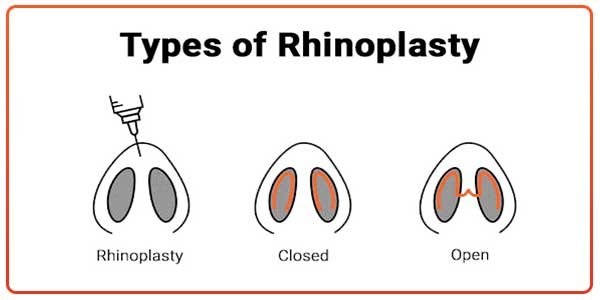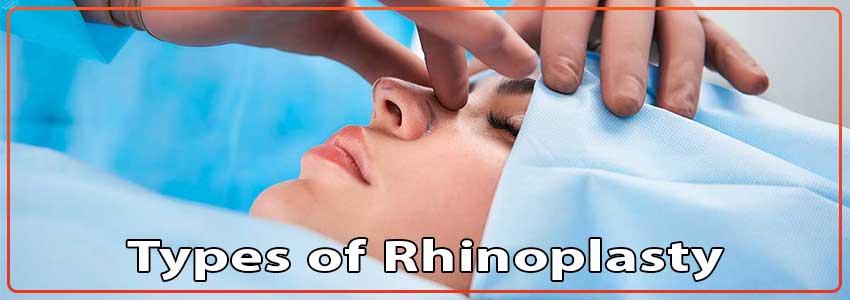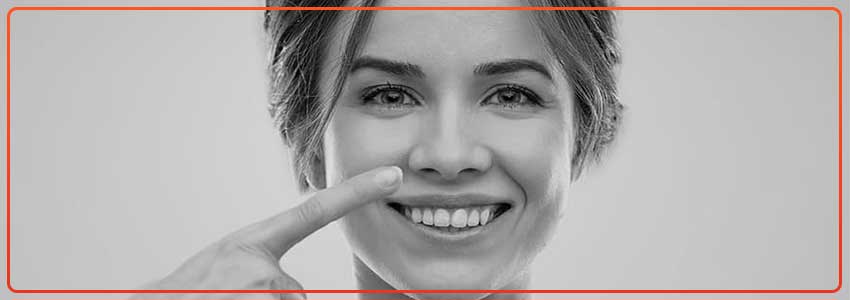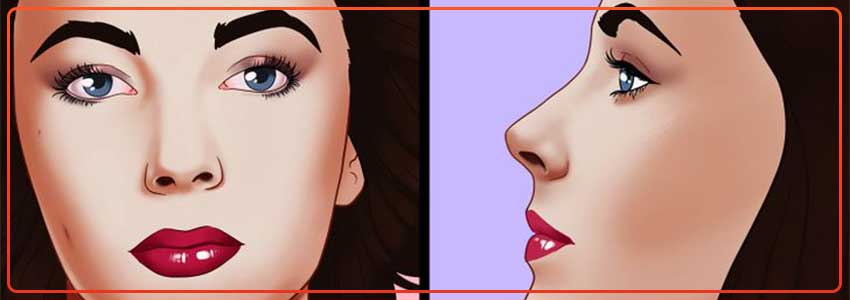Rhinoplasty is a surgical procedure done to improve the appearance of the nose. There are many different types of rhinoplasty, and each one has its own benefits and drawbacks. In this post, we’ll take a closer look at the different types of rhinoplasty, so you can decide which is right for you. Stay tuned!
Different Types of Rhinoplasty
Rhinoplasty has many types, and you may not be aware of it. However, if you keep reading, you will learn about each type of rhinoplasty and how it is performed.

Open rhinoplasty
Open rhinoplasty is a type of surgery that is used to improve the appearance of the nose. It is usually performed by making an incision on the outside of the nostrils, which allows the surgeon to have a clear view of the inside of the nose. This provides a more precise and customized approach to shaping the nose, and it can also be used to correct functional problems, such as a deviated septum. Open rhinoplasty is generally considered to be a safe and effective procedure, and most patients are very happy with their results. Overall, open rhinoplasty is an excellent option for those looking to improve the appearance of their nose.
Closed rhinoplasty
Closed rhinoplasty is a type of nose surgery that is used to improve the appearance of the nose. The term “closed” refers to the fact that the incisions are made inside the nose, rather than on the outside. This approach has several advantages. First, it generally results in less scarring. Second, it allows the surgeon to have more control over the shape of the final result. And third, it can sometimes be used to correct functional problems with the nose, such as a deviated septum. Closed rhinoplasty is usually performed under general anesthesia, and the surgery typically takes about two hours. Recovery from surgery usually takes about two weeks, and most patients can return to work and other normal activities during that time.
Secondary rhinoplasty
If you’re unhappy with the results of your primary rhinoplasty, you may be considering a secondary rhinoplasty. This type of surgery can be a great option for patients who have significant dissatisfaction with the shape or function of their nose. The most important thing to keep in mind is that a successful secondary rhinoplasty requires an experienced surgeon. This is because the nose is a complex structure, and correcting previous mistakes can be a challenge. When choosing a surgeon, be sure to ask about their experience with secondary rhinoplasty. Once you’ve found a qualified surgeon, they will work with you to develop a treatment plan that meets your individual goals. With proper planning and execution, a secondary rhinoplasty can help you achieve the nose you’ve always wanted.
Filler rhinoplasty
If you’re considering filler rhinoplasty, you’re not alone. This minimally-invasive Procedure has become increasingly popular in recent years, as it offers a way to achieve desired results without the need for surgery. And while there are many benefits to this approach, it’s important to be aware of the potential risks and side effects before making a decision. Fillers are injected into the skin to add volume and achieve a desired shape. However, they can sometimes cause bruising, swelling, and discomfort at the injection site. In rare cases, fillers can also cause an allergic reaction or migration of the product to other areas of the face. As with any Procedure, it’s important to consult with a qualified professional to ensure that filler rhinoplasty is right for you.
Which Type of Rhinoplasty is Right for Me?
When it comes to choosing the right type of rhinoplasty for you, it’s important to consult with a qualified surgeon. They will be able to assess your individual goals and help you choose the approach that will best meet your needs. In general, open rhinoplasty is a good option for patients who are looking for a more precise and customized result. Closed rhinoplasty is a good option for those who want to minimize scarring and have more control over the final shape of their nose.
And filler rhinoplasty is a good option for those who want to avoid surgery altogether. No matter which approach you choose, be sure to find a qualified surgeon who has experience performing the Procedure you’re interested in. With the right surgeon, you can achieve the beautiful and natural-looking nose you’ve always wanted. (Also Read: Nose Piercing)
The Consultation Process
The first step in the rhinoplasty process is to schedule a consultation with a qualified surgeon. During your consultation, they will assess your goals and evaluate your nasal anatomy. They will also discuss the different types of rhinoplasty and help you choose the approach that’s right for you. Once you’ve decided to move forward with surgery, your surgeon will develop a personalized treatment plan. This plan will take into account your specific goals and the unique characteristics of your nose. The consultation process is an important step in ensuring that you achieve the best possible results from your surgery.
Surgery Process
Rhinoplasty is typically performed under general anesthesia. This means that you will be asleep during the Procedure and will not feel any pain. The surgery usually takes 1-2 hours to complete. During the Procedure, your surgeon will make incisions in the skin of your nose. They will then carefully sculpt and reshape the underlying bone and cartilage to achieve the desired result. Once your surgeon is satisfied with the shape of your nose, they will close the incisions with stitches or tape.
Recovery Process
After surgery, you will need to rest and ice your face for the first few days. You can expect some swelling and bruising around your eyes, which will gradually subside over the course of a week or two. It’s important to avoid strenuous activity during your recovery, as this can cause additional swelling. Most patients are able to return to work and their normal activities after about two weeks. However, it may take several months for the final results of your surgery to become evident.
Real Patient Testimonials
Frequently Asked Questions
Q: What is filler rhinoplasty?
A: Filler rhinoplasty is a Procedure in which injectable fillers are used to alter the shape of the nose. This is an alternative to traditional surgery, which can be more invasive and require a longer recovery period.
Q: Who is a good candidate for filler rhinoplasty?
A: Filler rhinoplasty is a good option for those who want to avoid surgery altogether. It is also a good option for those who want to achieve a more precise and customized result.
Q: How long does the Procedure take?
A: The Procedure usually takes 1-2 hours to complete.
Q: How long is the recovery period?
A: Recovery from filler rhinoplasty is typically quick and easy. Most patients are able to return to work and their normal activities after about two weeks. However, it may take several months for the final results of your surgery to become evident.
Q: How many types of rhinoplasty are there?
A: There are fout main types of rhinoplasty: traditional surgery and filler injection. Each has its own advantages and disadvantages, so it is important to discuss with your surgeon which option is best for you.
Q: Which type of rhinoplasty is best?
A: There is no one “best” type of rhinoplasty. The best option for you will depend on your individual goals and desires. Your surgeon will be able to help you choose the best option for you.
Q: What is the most common rhinoplasty?
A: The most common type of Rhinoplasty is Closed Rhinoplasty, in which all the incisions are concealed inside the nose. You won’t have any visible scars after surgery.
Q: How much does rhinoplasty cost?
A: The average cost of rhinoplasty is $5,000. However, the cost will vary depending on the type of surgery you choose, your surgeon’s fees, and other factors.
Q: What is the easiest rhinoplasty?
A: The easiest rhinoplasty is filler injection. This is because it is less invasive and requires a shorter recovery period.
Q: What is better open or closed rhinoplasty?
A: Many patients prefer a closed rhinoplasty because there will be no visible scar following the operation. Many doctors, on the other hand, favor an open rhinoplasty because it allows for more precision and customization. Ultimately, the decision between an open or closed rhinoplasty will be up to you and your surgeon.
Q: How much does filler rhinoplasty cost?
A: The cost of filler rhinoplasty varies depending on the type of filler used and the extent of the Procedure. Typically, filler rhinoplasty is less expensive than traditional surgery.
Q: Is filler rhinoplasty safe?
A: Filler rhinoplasty is generally safe. However, as with any Procedure, there are some risks and potential complications that you should discuss with your surgeon beforehand.



